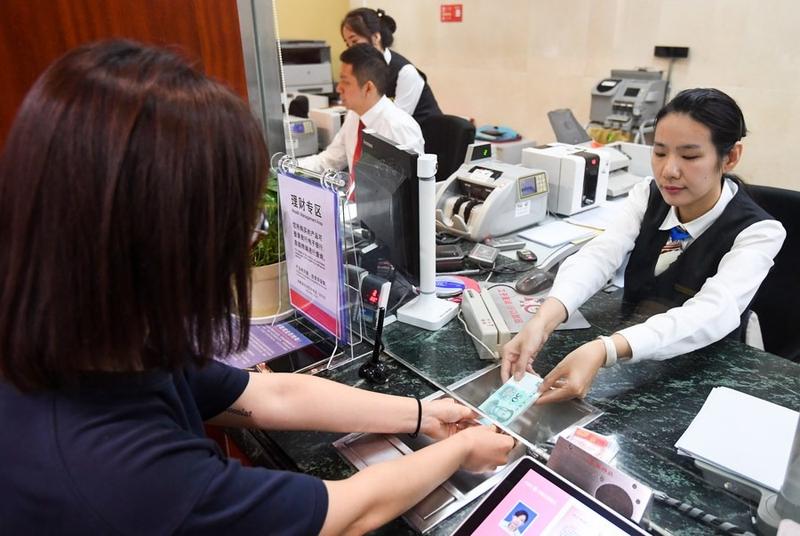 A staff member (right) hands over a stack of renminbi banknotes to a customer at an Industrial and Commercial Bank of China (ICBC) branch in Beijing, Aug 30, 2019. (PHOTO / XINHUA)
A staff member (right) hands over a stack of renminbi banknotes to a customer at an Industrial and Commercial Bank of China (ICBC) branch in Beijing, Aug 30, 2019. (PHOTO / XINHUA)
Moody's Investors Service, a New York-headquartered global credit ratings agency, said it holds a stable outlook on China's banking sector in spite of potential risks in the form of uncertainties over the green transformation's technological implementation.
Nicholas Zhu, vice-president and senior credit officer at Moody's, attributed the stable outlook to the solid asset quality of Chinese lenders and the economy's sustained recovery from the impacts of the COVID-19 pandemic.
Therefore, Moody's, which also provides research and risk analyses, has upgraded its ratings outlook for several Chinese regional commercial lenders from negative to stable.
We expect that China's gross domestic product growth will hit 8.5 percent this year. Besides, credit risks associated with excess capacity businesses and local government financing vehicles for infrastructure construction have been largely dealt with since the 2008 global financial crisis.
Nicholas Zhu, vice-president and senior credit officer at Moody's Investors Service, New York-headquartered global credit ratings agency
Among the lenders that received the upgrade are Bank of Nanjing Co Ltd, Bank of Ningbo Co Ltd, Bank of Suzhou Co Ltd and Shenzhen Rural Commercial Bank Corp Ltd, Zhu said.
"We expect that China's gross domestic product growth will hit 8.5 percent this year. Besides, credit risks associated with excess capacity businesses and local government financing vehicles for infrastructure construction have been largely dealt with since the 2008 global financial crisis," said Zhu on the sidelines of the CCXI 2021 Mid-Year Credit Outlook Conference in Beijing on Tuesday.
Mao Zhenhua, chief economist at China Chengxin International Credit Rating Co Ltd (CCXI), also forecast that China's economy may grow 8.3 percent year-on-year in 2021.
ALSO READ: Moody's: China's economic growth to stay robust in H2
During the economic recovery from the COVID-19 pandemic, China has ramped up efforts to prevent and control credit risk. Its banking sector disposed of 463.2 billion yuan (US$72.4 billion) worth of nonperforming loans in the first quarter, said Liang Tao, vice-chairman of the China Banking and Insurance Regulatory Commission, at a news conference on June 1.
By the end of the first quarter, the outstanding balance of nonperforming loans in the banking sector was 3.6 trillion yuan. The sector's NPL ratio was 1.89 percent, down 0.02 percentage point from the beginning of this year, Liang said.
Although experts do not expect systemic financial risks in China, they said credit risk will stay between large, systemically important banks and smaller regional banks whose asset quality is closely linked to regional economic performance and the industry segments they specialize in.
As the majority of small and medium-sized banks are rooted in cities or counties, the regulator-backed consolidation of several banks within a province will help reduce concentration of risk at the county-level, Zhu said.
"Looking ahead, China's structural adjustment, such as the transition toward a green economy, may amplify risk transmission to its banking sector in the long run, as the trajectory of a green transformation's technological implementation still remains uncertain.
"A bank may face higher credit risks in underwriting emerging technologies because many green technologies are evolving with low predictability of potential returns and obsolescence risks. Banks will be compelled to adapt to rapid shifts in the technological and regulatory environment and in borrower behavior," he said.
In the short term, banks are likely to see a continued increase in their impairment charges for non-loan assets, such as bonds with high default risks. This is to comply with China's new asset management rules, which aim at reining in risky shadow banking practices in the financial system.
READ MORE: EU fines Moody's for failing to disclose conflicts of interests
Moody's said that 15 major Chinese banks' non-loan asset impairment charges doubled year-on-year in 2020.
The trend is expected to continue as banks get ready for the final implementation of asset management rules by the end of this year, he said.


